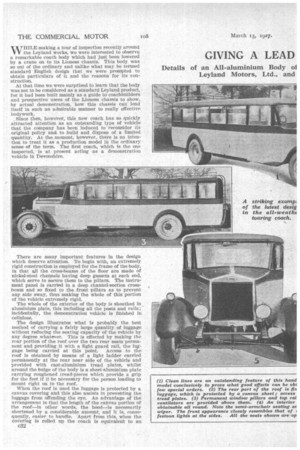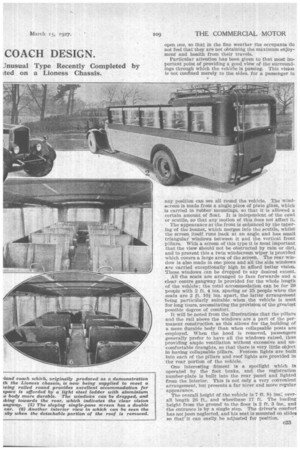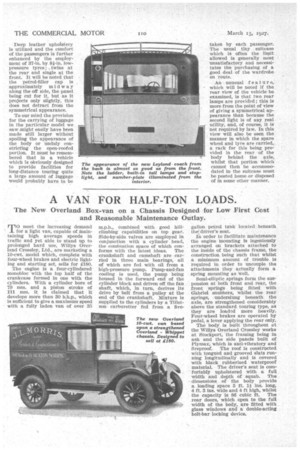GIVING A LEAD COACH DESIGN.
Page 54

Page 55

Page 56

If you've noticed an error in this article please click here to report it so we can fix it.
Details of an All-aluminium Body ol Leyland Motors, Ltd., and Jnusual Type Recently Completed by Lted on a Lioness Chassis.
WHILE making a tour of inspection recently around the Leyland works, we were interested to observe a remarkable coach body which had just been lowered by a crane on to its Lioness chassis. This body was so out of the ordinary and unlike what may he termed standard I English design that we were prompted to obtain particulars of it and the reasons for its construction.
At that time we were surprised to learn that the body was not to be considered as a standard Leyland product, for it had been built mainly as a guide to coachbnilders and prospective users of the Lioness chassis to show, by actual demonstration, how this chassis can lend itself in such an admirable manner to really effective bodywork. , Since then, however, this new coach has so quickly attracted attention as an outstanding type of vehicle that the company has been induced to reconsider its original policy and to build and , dispose of a limited quantity. At the moment, however, there is no intention to treat it as a production model in the ordinary sense of the term. The first coach, which is the one inspected, is at present acting as a demonstration vehicle in Devonshire.
There are many important features in the design which deserve attention. To begin with, an extremely rigid construction is employed for the frame of the body, In that all the cross-beams of the floor are made of nickel-steel channels having deep gussets at each end, which serve to secure them to the pillars. The instrument panel is carried in a deep channel-section crossbeam and so fixed to the front pillars as to prevent any side sway, thus making the whole of this portion of the vehicle extremely rigid.
The whole of the exterior of the body is sheathed in aluminium plate, this including all the poets and rails ; incidentally, the demonstration vehicle is finished in cellulose.
The design illustrates what is probably the best method of carrying a fairly large quantity of luggage without reducing the seating capacity of the vehicle by any degree whatever. This is effected by making the rear portion of the roof over the two rear seats permanent and providing it with a light guard rail, the luggage being carried at this point. Access to the roof is obtained by means of a light ladder carried permanently at the rear near side of the vehicle and provided with cast-aluminium tread plates, whilst around the bulge of the body is a sheet-aluminium plate carrying roughened tread-pieces which provide a grip for the feet if it be necessary for the person loading to mount right on to the roof.
When the roof is used the luggage is protected by a canvas covering and this also assists in preventing the luggage from offending the eye. An advantage of the arrangement is that the length of the canvas portion of the roof—in other words, the hood—is necessarily shortened by a• considerable amount, and it is, consequently, easier to handle. Apart from this, when the covering is rolled up the coach is equivalent to an
(1) Clean lines are an outstanding feature of this hand model conclusively to prove what good effects can be obi few special orders. (2) The rear part of the roof is fis luggage, which is protected by a canvas sheet ; access tread plates. (3) Permanent window pillars and top rai ventilators are provided above them. (4) An interior obtainable all round. Note the semi-armchair seating at wiper. The front appearance closely resembles that of festoon lights at the sides. All the seats shown are op 'land coach which, originally produced as a demonstration th the Lioness chassis, is now being supplied to meet a ming railed round provides excellent accommodation for space is afforded by a light steel [adder with aluminium le body more durable. The windows can be dropped, and )king towards the rear, which indicates the clear vision angway. (5) The sloping single-pane screen has a double car. (6) Another interior view in which can be seen the sky when the detachable portion of the roof is removed.
open one, so that in the fine weather the occupants do not feel that they are not obtaining the maximum enjoyment and health from their travels.
Particular attention has been given to that most important point of providing a good view of the surroundings through which the vehicle is passing. This vision is not confined merely to the sides, for a passenger in any position can see all round the vehicle. The windscreen is made from a single piece of plate glass, which is carried in rubber mountings, so that it is allowed a certain amount of float. It is independent of the cowl or scuttle, so that any motion of this does not affect it.
• The appearance at the front is enhanced by the tapering of the bonnet, which merges into the scuttle, whilst the screen itself runs back at an angle and has small triangular windows between it and the vertical front pillars. With a screen of this type it is most important that the view should not be obstructed by rain or dirt, and to prevent this a twin windscreen wiper is provided which covers a large area of the screen. The rear window isalso made in one piece and all the side windows are carried exceptionally high to afford better vision. These windows can be dropped to any desired extent.
All the seats are arranged to face forwards and a clear centre gangway is provided for the whole length of the vehicle; the total accommodation can be for 29 people with 2 ft. 4 ins, spacing or 25 people when the seats are 2 ft. 10/ ins, apart, the latter arrangement being particularly suitable when the vehicle is used for long tours, necessitating the provision of the greatest possible degree of comfort.
It will be noted from the illustrations that the pillars and the rail above the windows are a part of the permanent construction as this allows for the.building of a more durable body than when collapsable posts are employed. When the hood is removed, passengers generally prefer to have all the windows raised, thus providing ample ventilation without excessive and uncomfortable draughts, so that there is very little object in having collapsable pillars. Festoon lights are built Into each of the pillars and roof lights are provided in the rear portion of the vehicle.
One interesting fitment is a spotlight which is operated by the foot brake, and the registration number-plate is built into the rear panel and lighted from the interior. This is not only a very convenient arrangement, but presents a far nicer and more regular appearance.
The overall height of the vehicle is 7 ft. 8.), ins:: overall length 26 ft., and wheelbase 17 ft. The loading height from the ground to the floor is 2 ft. 3 ins., and ?the entrance is by a single step. The driver's comfort has not peen neglected, and his seat is mounted on slides so that it can easily be adjusted for position.
Deep leather upholstery is utilized and the comfort of the passengers is further enhanced by the employment of 37-in. by 81-in. lowpressure tyres; twins at the rear and single at the front. It will be noted that the petrol-filler cap is approximately midway along the off side, the panel being cut for it, but as it projects only slightly, this does not detract from the symmetrical appearance.
To our mind the provision for the carrying of luggage in the particular model we saw -might easily have been made still larger without spoiling the appearance of the body or unduly constricting the open-roofed portion. It must be remembered that in a vehicle which is obviously designed to provide facilities for long-distance touring quite a large amount of luggage would probably have to be The appearance of the new Leyland coach from the back is almost as good as from the front. Note the ladder, built-in tail lamps and stoplight, and number-plate illuminated from the taken by each passenger. The usual tiny sttitease which is often the limit allowed is generally most unsatisfactory and necessitates the purchasing of a good deal of the wardrobe en route.
An unusual feature, which will be noted if the rear view of the vehicle be examined, is that two rear lamps are provided ; this is more from the point of view of giving a symmetrical appearance than because the second light is of any real utility, and, of course, it is not required by law. In this view will also be seen the manner in which the spare wheel and tyre are carried, a rack for this being provided in the rear of the body behind the axle, whilst that portion which cannot then be accommodated in the suitcase must be posted home or disposed of in some other manner.












































































































